I jokingly call the day before the ATY races begin "Day Zero" since
the race days are officially called Days 1, 2, and 3. It felt like
ground zero this year; so many things were
happening, and Jim and I were even more in the thick of it than
we were
last year.
Fortunately, the weather got warmer on Sunday. It was below
zero degrees Celsius the previous two mornings at Nardini
Manor (upper 20s Fahrenheit). That's colder than average
at a thousand feet of elevation in the Valley of the Sun. Runners were fortunate
during the race this year that each day was warm and sunny and the night-time temperatures,
while typically cold in the Sonoran Desert after the sun goes down, were a little
warmer than during last year's race. Many runners coming to the
event for the first time are surprised how cold southern Arizona
can be at night in late December.
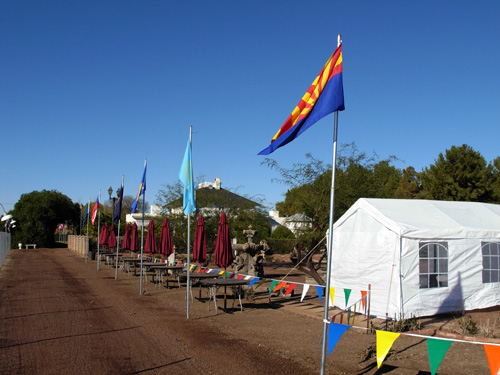
The new remote "quiet tent" is ready
to accommodate its assigned runners on 12-28-09.
What a beautiful day!
Since Jim would start his 48-hour run on Monday (Day 1) he got
up a little
later on Sunday morning, just in case sleep eluded him the night
before his race. (Good decision; it did.) His main goals for the day were to rest
as much as possible and to get his clothing, gear, and other
items ready. He still found the energy and time to
assist with a few more pre-race chores in the morning before
runners began arriving, however. He worked with Dave and Rodger
on web cam issues, put up more tent walls, and found
some other light tasks to do. It was hard for him to just sit
still.
Me, too.
I didn't worry about wearing myself out, though, because I wasn't running
until Wednesday (Day 3) and was going for "only" 24 hours, not 48.
I
helped Jim set up our personal
aid table and chair across from the mailboxes,
near a lamppost and stone bench that various runners used over
the next three days. We'd carry his supplies out there in the
morning. Don Lundell and Gillian Robinson were on
one side of us the first two days, then Kay Blom and her crew (husband
Keith) on Day 3. Robert Andrulis, Lynn Newton, and John Geesler
were other neighbors toward the timing mat. In the photo below, our table and chair are in the left
foreground. Jim took the picture on Day 3 as I'm running toward
him. The timing booth is behind me and the mailboxes are on the
right.
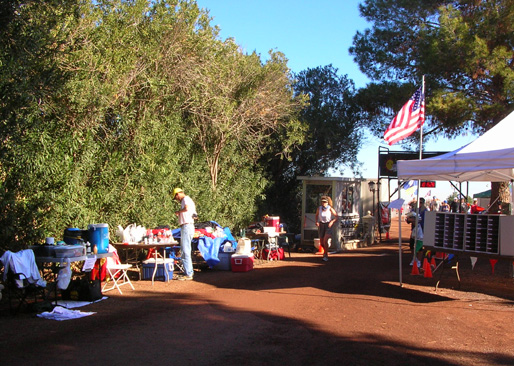
On the other side of the
bench was Scottish 72-hour runner
William Sichel's table,
staffed by Alan Young, a handler we later learned was
paid. Now there's an interesting ultra-related job! We've
never heard of a professional crew person in this sport but it's
common in some others. Anyway, it apparently "paid off" for
William. He not only
won the 72-hour race this year
with 269+ miles, a margin of
almost 34 miles over his nearest competitor, he also set a new Scottish national record.
I heard before the race that William was hoping to exceed 300
miles but that has happened only twice in this race. Yiannis Kuoros has the ATY 72-hour
record at 323 miles (2005).
John Geesler is the only other runner at ATY who has reached 300
miles (2004). Although John finished the race this year, he was
injured on the first day and unable to mount a challenge for the
win. (More about his remarkable story later.)
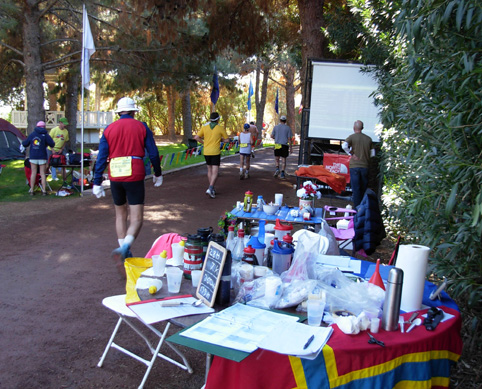
William Sichel's personal aid table.
12-29-08
After Jim went back to the camper, Cody and I picked up pine
cones in the treed area, walked around the track one
last time, checked on the "bag room" to be sure everything was
ready for registration that afternoon, and got last-minute instructions from Rodger regarding a few specific
runner's situations that I'd need to handle during check-in.
That was the last time for several days that Cody and the Wrubliks' two dogs had the run of the place.
Then I got to socialize with incoming runners for a little while as they began
trickling in around lunch time. That's
one of the most fun aspects of this or any other race:
greeting and hugging old friends, and meeting new ones that
will be "old friends" in another three days.
HELLO! IT'S GREAT TO SEE YOU AGAIN!!
Runners began arriving late Sunday morning to set up
their cots or little tents in the big 60x100-foot heated tent,
decide where to put
their personal aid stations along the track, and check out the
course improvements they'd read about on the
race website. Most of them
were entered in the 72-hour race or the first wave of the
48-hour race, which began at 9 AM the next morning. All of them knew
that space in the big tent would be at a premium this year
because more runners were entered in the race than ever before (at least ten more
in the 72-hour race than last year and a couple more in the 48).
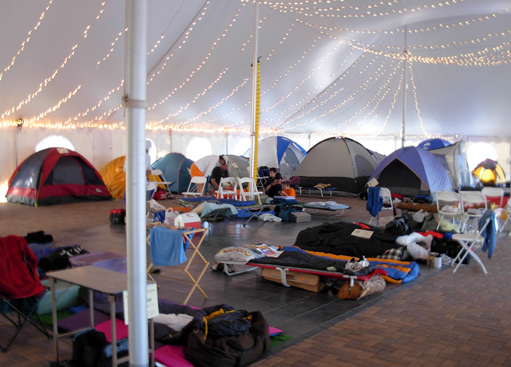
Cots and sleeping bags go in the middle,
tents around the perimeter.
Race organizers encouraged the runners to limit their tents to
10x10 feet or smaller and warned them that even with smaller
tents, there wouldn't be room for everyone inside the big
tent. It's first-come, first-served, so Sunday arrivals were soon
jockeying for floor space. Veteran ATY runners know they need to
be among the first to arrive so they can have a better selection
of places to set up their tents or cots.
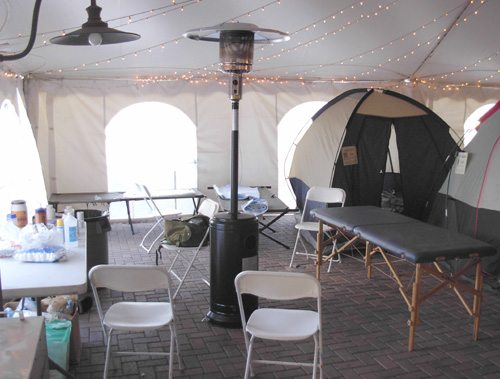
One corner of the big tent is reserved for
Christopher's and Andy's busy medical area.
Those who arrive later may
find themselves out in the cold, literally. Of course, some
runners choose to set up their tents outside in one of
the grassy areas where it's quieter and they have more room. This is also
the suggested option for runners with several crew members and/or kids who will
be staying at Nardini Manor overnight since space is at a
premium inside the big tent. There isn't enough room for crew
members to erect separate tents inside.
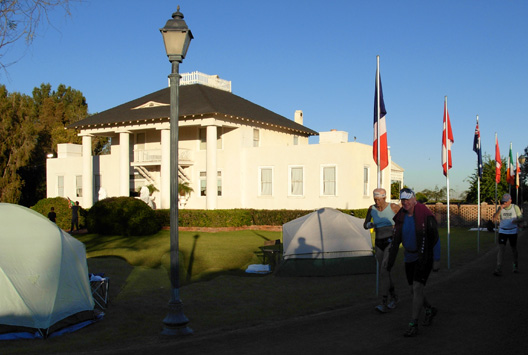
Runners pass several tents set up near the
track in the front yard.
Other runners who would be sleeping in their campers, vans, or
SUVs in Nardini Manor's parking area or in nearby motels
also trickled in throughout "Day Zero." It was like a homecoming --
or family reunion, since this race truly has a family feel to
it. The majority of runners each year have been here previously.
First-time ATYers soon feel like they've been here before, too.
I know that's how Jim and I felt last year. Veterans are usually
eager to answer questions and help the newcomers feel right at
home. To me, that's one of the best things about ATY and now I
make it my job to give a warm welcome to first-time ATYers, too.
SOCIAL & COMPETITIVE DYNAMICS
A fixed-time race on a loop this short is a very social event.
Runners are never alone at ATY for more than a few seconds, even at
night. It's one of the biggest differences between
fixed-time ultras with relatively short loops and fixed-distance ultras (50K, 100
miles, etc..), especially those
that are point-to-point. After a while in most trail races, the pack spreads out and
those on the shallow ends of the Bell Curve (runners in the front
and back) can find themselves
pretty much alone the second half of the race.
That's definitely
not the case at ATY. With runners in three different events on
the course at the same time, there is an interesting mix of
speeds and form. Those of us who would be near the back of the
pack in a point-to-point race share the track with runners for
one, two, or three days who we'd normally see only at the start
and finish because they'd be so far ahead of us. By the third day and
night, runners who have already been out there for over 24 or 48
hours are wearing down and pacing off fresher runners who
started more recently. One of the coolest race experiences I've
ever had was during the third night here when several of the
high-mileage 48- and 72-hour runners were pacing off ME because
I was walking so "fast" in comparison! I didn't notice that last
year when I ran the second day.
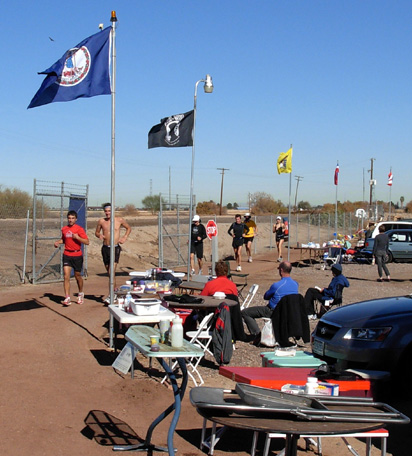
Day 1 runners pass personal aid stations
set up at the edge of the parking area;
day or night, you're never alone for long
in this race.
One of the characteristics about ultra runners that sets them
apart from runners in shorter-distance races is their
camaraderie with the other race participants; your first
time at ATY you discover this very quickly. Not only are most
(most) folks genuinely friendly but they are also generous with
encouragement and praise -- even with the runners they consider
to be their competition.
As in most ultras, "competitive" ATY runners of all speeds
and ages
tend to prefer some good competition to bring out their own best
efforts. You may be the fastest guy or gal out there, but if no
one is pushing you, you may not do as well as you could.
Just ask Juli
Aistars, Aaron Sorenson, and Martina Hausmann about this year's
competition for second, third, and fourth places in the 72-hour
race. By pushing each other they all
finished within a small
mileage range after three days and nights on the track. They may
not have been very talkative the first day when they were
running steadily the majority of the time (or walking fast, in Martina's
case), but even they
were talking more to each other and the other runners as they
progressively slowed down the second and third days. There are
lots of other similar stories at ATY each year.
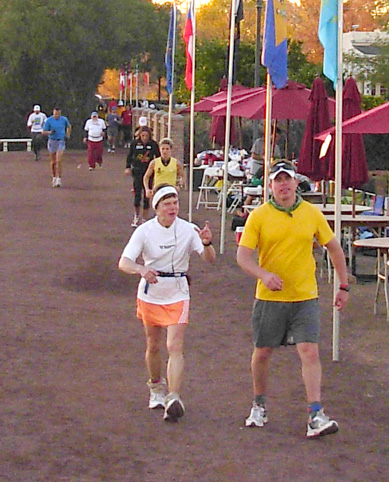
German runner Martina Hausmann (L) chats animatedly with
Rick Cheever on Day 1.
Veteran of many 6-day races, she racked up
231 miles (mostly walking) in 72 hours, placing 4th.
At ATY all the 72-hour runners are on the track the same three
days. It's easy in that race to periodically check the leader
board and see how you stack up against the competition at any
given time.
Not so in the 48- and 24-hour races. The competitive strategy is
different because there are two waves of 48-hour runners and
three waves of 24-hour runners. Assuming the weather is similar
on all three days, runners on the track during Days 2 or
3 have an advantage because they know what distances they have
to exceed in order to win or place higher in the standings. This
became apparent in the "duel" between Hans Bern-Bauer, who ran
in the first wave of the 48-hour runners, and Jeff Hagen, who
ran 15 miles farther in the second wave. If they'd been on the
track the same days, both would likely have run even farther.
Same thing in the 24-hour race between Matt Watts (Day 1) and
Wendell Doman (Day 3). The placement may have been the same
(Wendell went farther),
but they probably would have pushed each other harder if they'd
both run on the same day.
This really doesn't apply to runners who are
mainly trying to reach a certain mileage goal (like Jim) or to
beat a
previous ATY single-age record (like me). I enjoyed running the third day,
however, because it was more fun being the "hunter" than the
"hunted" as I watched my name rise higher and higher on the
leader board! Yep, I still have some competitive spirit in me.
So does Jim. Unfortunately, since he ran in the first (and
smaller) wave of 48-hour runners, he saw himself slide farther
down the leader board when some of the runners in the second
wave caught up to the first wave.
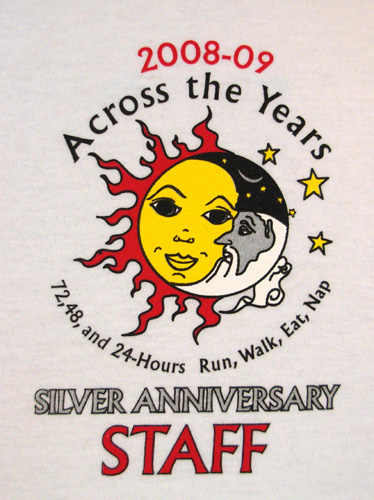
Cool logo on volunteers' shirts
Back to the subject of socializing during the race
. . . there's quite a range of "talk levels" and it changes
from day to day as the runners get more tired.
Ones who were running too fast to talk at the beginning of their
race might become more loquacious when they have to walk more.
Others are more talkative when they're fresh, then withdraw
during the night when they are sleepy or starting to hurt.
There are some ATY runners and walkers who love the opportunity to talk to other
participants the entire time they're circling the track. It's a
wonder they aren't hoarse after three days! A few
are non-communicative except during breaks. Most are somewhere
in the middle.
Whether you socialize a little or a lot at ATY, it's fun to get to know one another better and
the miles seem to add up faster when you're lost in conversation.
Not all distractions are bad. Shared experiences like this can
produce
bosom buddies, fond memories, and perhaps even a personal record.
Regardless of your speed, on a 500-meter course you can't escape the
presence of other runners during this race. Some runners wear
headphones so they can focus on their race (or forget about it)
and not be distracted by conversations with other runners. About
the only other way to avoid talking without appearing rude is to run so fast no one can keep
up with you! But even the runners who are focused on personal,
age, or national records usually take some time to socialize
during the race.
BUILD IT & THEY WILL COME
One of the new features this
year was the opportunity for runners to check in and receive their bags,
bibs, and timing chips on Sunday afternoon, not just the morning
their race began as in previous years. The
main reasons for this change were the increase in the number of
runners and the desire to avoid chaos the morning of Day 1. It
worked.
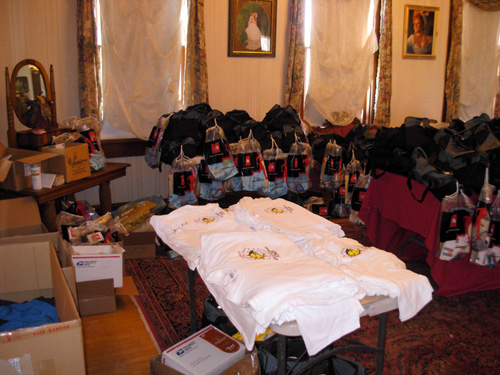
Volunteer shirts (center), 48-hour runners'
bags and packets (rear). It's more organized than it looks!
Rodger came up with this great idea after realizing how many
runners (about 80 of them) would have to check in from 7-9 AM on
the first day of the race. I had a
vested interest because I was one of only two people assigned to
the task that morning and I was plenty worried. I highly recommended that more volunteers be
assigned to help us with the onslaught. I remembered how hectic it was last year
with fewer runners, especially since several items were handed out
separately from the bags. Even though all the items were in the
bags and attached packets this year, having so many people sign their medical forms and
check in would still be very hectic right before the race.
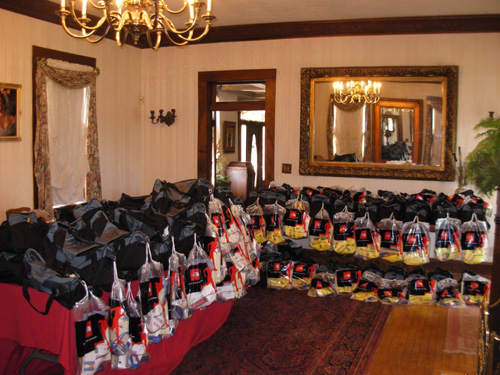
On the other side of the room, the 24-hour
(L) and 72-hour bags and packets
are ready to be claimed. The living
room is through the door. 12-28-08
As soon as Rodger decided to have early check-in on Sunday
afternoon I volunteered to handle it.
The process didn't look at all daunting spread out over five
hours. If enough runners checked in that day it would reduce a lot of pressure
for the runners and volunteers on the first morning of the race.
But would they come?
Oh, yes!
To my delight, at least 60 or 70 runners, about half the field
for all three days,
checked in on Sunday afternoon between 1 and 6 PM. Unfortunately, I forgot to
count them after checking off their names. I do know the "bag
room" looked decidedly more empty by dinnertime.
There were two
periods of time when it took two or three of us (runners Sandy and Mike
Melton helped me that day) to handle the process because several
people showed up at once, but in general the afternoon was
relaxed enough to be able to socialize with the runners, answer
all their questions, solve all their problems (just kidding!),
and give them information they needed to know.
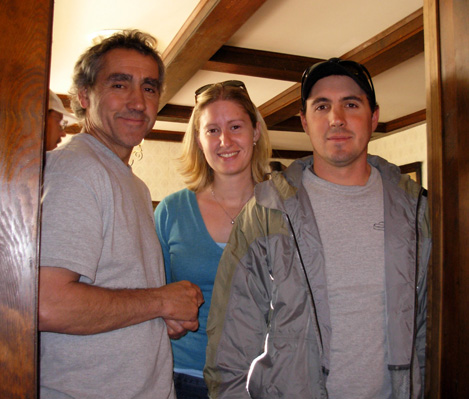
72-hour running friend Ray "K" Krolewicz
(L) came to check-in
with his son Jon (R) and Jon's girlfriend,
Melissa. 12-28-08
The runners who showed up liked being able to get their bags and
packets the day before the race. I did, too. As a runner, I like getting my number, shirt,
and other
paraphernalia the day before a race. It also made my volunteer job so much
more enjoyable that day and the next two mornings (I ran on Day
3, so someone else handled the few remaining runners who checked
in Wednesday morning).
The new traffic pattern for check-in was also a hit with the
runners and volunteers.
Runners were directed into the house via the front porch this
year, not the back veranda.
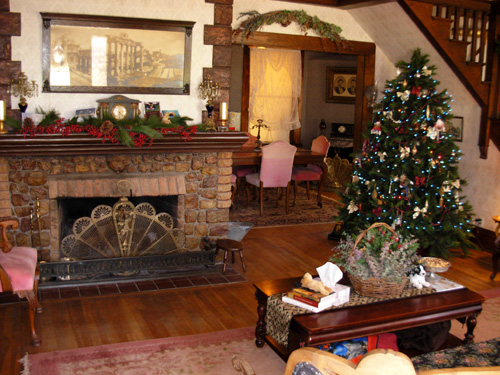
They had lots of room to congregate in the living room (above) as they filled out their
medical forms, and traffic was kept completely out of
the adjacent room (next photo) with all the runners' bags and packets, volunteers' shirts, awards, etc.
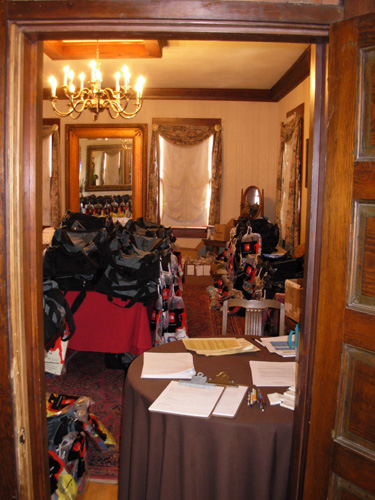
Registration table and room with the
runners' bags, etc.
Everyone enjoyed
the Wrubliks' comfortable, antique-filled living room with its
beautifully decorated Christmas tree, blazing fireplace, and cookies to
eat. Remember what I said about the family's outstanding
hospitality in the
last entry? This is just one
more example.
Runners also liked the duffel bags and their contents. Here's
more about the new "goody bag" option at ATY this year . . .
GOODY BAG: IT'S YOUR CHOICE
Most ultras charge one standard fee that includes a garment or some type of gear given to entrants
and/or finishers. The fee may increase the closer you get to the
race, but everyone pays the same amount if they enter the same
distance race within the
same time period -- and they all get the same stuff (commonly
called "schwag," "premiums," or "goodies").
Some people don't give a hoot about the schwag or awards and just want a
fun, safe, challenging race. Why should they have to pay extra
for goodies they neither want nor need?
Only a few ultras give entrants the
choice of paying a basic fee to run the race and paying a
separate fee for
a race shirt or other amenities.
ATY adopted such a goody bag option for the event this year;
about 15% of the runners chose to pay only the basic race fee.
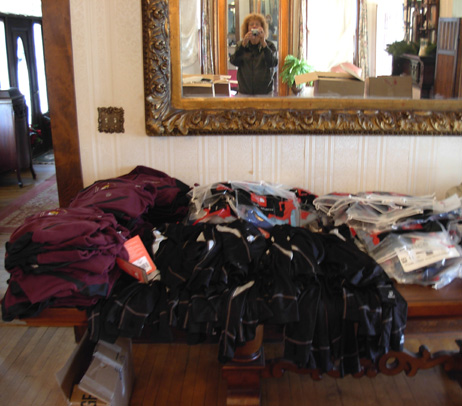
Women's fleece jackets (left) and shirts
organized for bag-stuffing on 12-13-08.
The photographer takes a picture of herself
taking a picture . . .
Jim and I have never run an ultra based solely on the shirt or
other items given to the participants. There are more important
things to consider first. But it IS one of many factors we
consider when we sign up for a race the second and subsequent
times. Are we getting good value for our race dollar, not only
in terms of good organization, nice scenery, a safe course, and
aid station offerings, but also in terms of the entrants' and/or
finishers' clothing or gear? That assessment can be
difficult our first time at a race, but after that, we pretty
well know if we "got our money's worth" in all respects and want
to go back again.
Across the Years is a unique event that has gained a
well-deserved reputation for many reasons. One of those reasons is the
quality and style of the clothing and other items that are offered to every
entrant. Note that I said entrant, not finisher. You don't have to beat what might be an impossible
cut-off to "get what you pay for" at ATY. I've written
previously about feeling "taken" when high entry fees go toward
expensive clothing or other items given only to the finishers.
That was never an issue for Jim and me until we began to
significantly slow down in our mid- to late 50s. Now it's one more thing we have to
consider when we enter races. (It's not a problem if we choose
races with generous cut-offs for us, only tight ones. We may be
slower than we used to be, but we can usually still do the
distances.)
At the
time of on-line registration for ATY last summer entrants had to decide
if they wanted to spend only the basic fee for the race they
wanted to run or pay an additional amount to receive a high-quality
technical running shirt and fleece jacket, a well-made
duffel bag with the Silver Anniversary race logo, a pair of
Dirty Girl gaiters, and other items
that typically retail
for substantially more than what the race was charging for them
(this year's shirt and jacket retail for about one-and-a-half
times the fee, not including the duffel bag and other items
included). That's an excellent value if you want the items
because you're not likely to get them anywhere else except the
race for that price -- or with the very cool race logo!
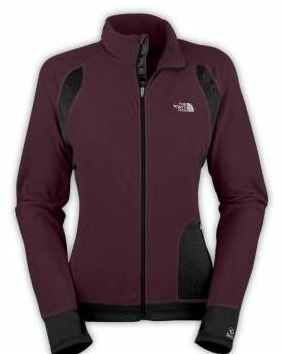
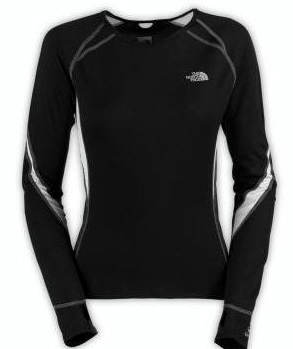
Women's attractive Northface Borealis zippered fleece
jacket (L) and crew neck Reckoning shirt
But what a great "no-bag" option for those
who already have enough running clothes and/or want to economize! This
year's basic entry fee without the goody bags was less than
in previous years when the cost of the goodies was automatically
included. That's a win-win for the runners. And the ones who took the "no
bag" option didn't exactly go home empty-handed. They received Drymax
socks, Zombie Runner samples and coupons, Hammer Nutrition
products, and some other items that sponsors provided for all
the runners. That was also an excellent value.
Jim and I love the Northface shirts and jackets, Dirty Girl gaiters,
Moeben Sleeves, duffel bags, and
other items we received at ATY last year; we didn't even have to
think when registering this year before saying yes, we each wanted
to pay for
a goody bag. For us, it was a good deal. The decision was tougher for those who haven't
participated at ATY before and didn't fully know what they might be
missing. To help runners make their decision, there was a link to
photos of this year's Northface shirts and jackets on the ATY
web site. Anyone could go there, read about the items, see
what the retail prices were, and make an informed decision. Or
they could contact Paul or Rodger and ask as many
questions as they wanted.
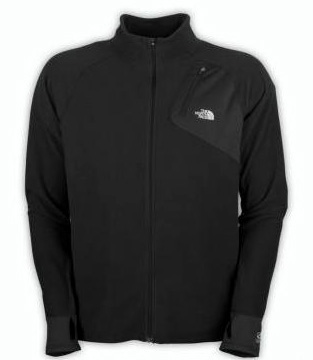
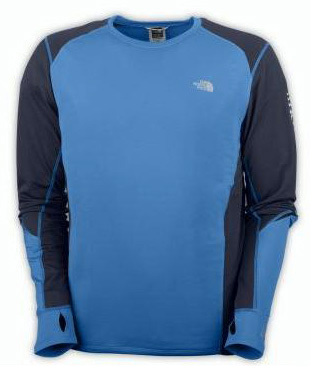
Men's handsome fleece full-zip Northface
Borealis jacket (L) and Impulse crew
We think
ATY's fees are very reasonable when compared to the cost to
enter other high-quality ultras around the country. In fact,
they are lower than most of them, considering all the
tangible and intangible things you get. The ATY race committee does a good job controlling costs.
One way they do this is to order very few extra shirts and
jackets beyond what the runners initially choose when they enter
the race. The extras are reserved for runners who need to change
sizes from what they ordered and to reward volunteers who go
"above and beyond." Runners were warned in the directions
before entering the race that there might not be any extra
shirts or jackets if they chose the "no bag" option when they
registered, then later changed their minds.
I was very grateful last year when I needed to swap for a larger
shirt at ATY and received one that I wear frequently and with pride. There weren't any
larger women's shirts left, so Rodger gave me a men's shirt that
fits me well. Since I knew this year's shirts were coming
from the same manufacturer, I ordered a larger women's shirt and it fits
fine. Women can choose to order men's clothing at ATY (and
a few did this year) if they prefer the men's styles/colors or the
sizing is more appropriate. In addition, entrants may order extra shirts or
jackets (at extra cost) but they need to do this when they
register.
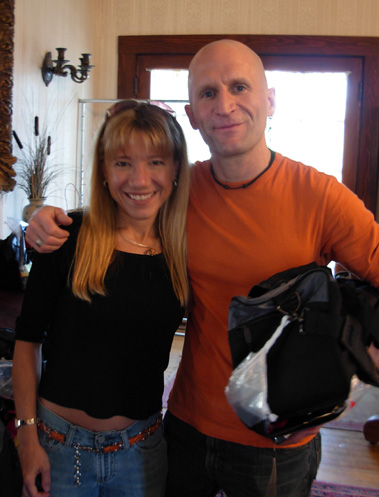
48-hour runners Lisa Bliss and Tim Englund
pick up their race bags.
All but one runner I checked in on Sunday, Monday, and Tuesday
seemed happy with their choice re: the goody bag. One woman
who opted for "no bag" was very angry that she was unable to change her mind and
get one at check-in on Sunday.
She saw how nice the items were and deeply regretted her
decision. (A big problem was that she didn't register herself or
even take the time to read about her options.) I don't know if there was anything left after the awards
ceremony on January 1 for her to purchase, or if she even stayed
in town that long.
Other than that unpleasant incident, I thoroughly enjoyed
handling registration on Sunday afternoon and getting to see so
many runners and their crews. It's definitely one of my favorite
race jobs!
IS JIM READY FOR HIS RACE?
While I was having fun at check-in Jim was trying to rest, go over
his intended race splits for the umpteenth time, and otherwise get
ready to begin his first 48-hour race the next morning -- kind
of daunting, I'd imagine. He emerged from the camper
periodically to see what was going on and to socialize with incoming runners.
He had his priorities right! There wasn't much more he could do
preparation-wise anyway. I got to see
and talk to more runners when they checked in at the house,
but Jim got to spend more quality time with some of them outside as they
shared their race goals and strategies, talked about their training
for ATY, and caught up on their respective adventures since the last time they
saw each other. I didn't miss much; I could do that on
the track on Day 3 when most of the 48- and 72-hour runners were
tuckered out and mostly walking!
Jim's day was going great until late afternoon. He moved the
truck alongside the camper to empty 55 gallons of water from our
supplemental water tank into the camper's tank so we wouldn't
run out of water during the race. Then the truck wouldn't start. Oh, no!
Fortunately, it wasn't blocking the parking lot or taking
up unnecessary room, but Jim wanted to move it back to its
original spot in front of the camper tongue during the race.
Worse, it was almost dark and he didn't have enough time to ascertain what the problem was. He located Rodger and told him why the truck
was parked where it was. Rodger said not to worry; he'd help him
figure out what the problem was during daylight on Day 3, after Jim's run was
over.
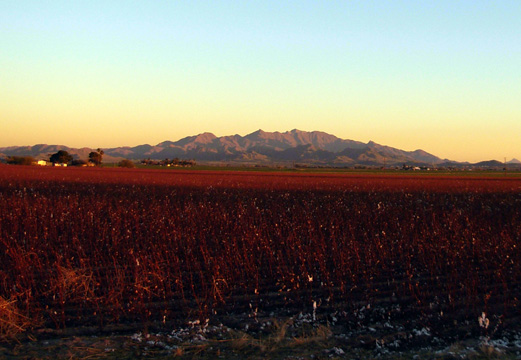
The setting sun colors the harvested cotton
field next to Nardini Manor.
I had no clue what happened until I closed down registration at
6 PM and headed "home." It was deja vu all over again.
This was almost as bad as Leadville 2007 when the truck died a
quarter mile from the start -- half an hour before the start -- and I had to
hurriedly borrow runner Brent Craven's
truck to crew for Jim during the 100-miler. Jim worried about
that truck the entire race; it was one of several reasons
he DNF'd the race.
We both knew it would bother him
for two days during ATY. Not knowing what was wrong was worse
than knowing, because we didn't know if this was a $50 problem
or a $5,000 one. It's almost like when you have a physical
problem and haven't gotten it properly diagnosed yet. It'll
drive ya crazy.
Jim was already nervous enough about his race; he didn't need
this extra worry. (The good thing about having an older truck is
that it's paid for. The bad thing, of course, is having to make
expensive repairs as it ages. Again, kinda like the extra
medical bills people incur as they age!)
We tried to put this problem out of our minds while we ate
supper and shared stories from our
separate conversations during the day with running friends from
far and wide. There wasn't a thing we could do about the truck
for at least two more days. Thank goodness we were "stuck" at
Nardini Manor with another mechanic (Rodger) and plenty of tools nearby
and not somewhere in the middle of nowhere on I-10 in New Mexico. I knew
Jim and Rodger could figure out what was wrong when they had the time.
I encouraged Jim to put the truck out of his mind as best as he
could and focus on getting a good night's sleep before his race.
I was already thinking more about how to get up, get dressed, and
make my coffee quietly the next morning, without waking Jim up
that early, so I could get over to the house to do runner check-in
at 7 AM.
Both of us were tired enough to go to bed early that night.
It was almost show time!!!
Next entries: Days 1 and 2 at ATY -- Jim's first 48-hour
run
Cheers,
Sue
"Runtrails & Company" - Sue Norwood, Jim O'Neil, Cody, and
Tater (in spirit)
Previous
Next
© 2008 Sue Norwood and Jim O'Neil





















